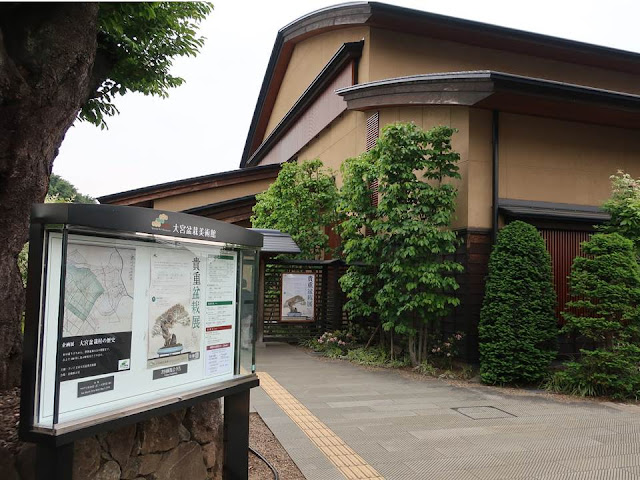 |
| Red pine、赤松 |
After Kanto big earthquake* which occurred in 1923, many Bonsai artisans moved to Omiya which is located
30km north from Tokyo. In 2010, this Bonsai museum was built in Omiya. Recently this has becomes a very popular tourist spot for foreign visitors. It is no doubt that
Bonsai is art and sophisticated hobby. Bonsai in this museum are made by Bonsai
artisans with great care, so some even have those own names and those are
priced for more than $10,000. Surprisingly some even cost $1,000,000. Even ordinary
people appreciate Bonsai in their houses, but here is a different world.
* Kanto big earthquake
https://en.wikipedia.org/wiki/1923_Great_Kant%C5%8D_earthquake
2010年開館の盆栽の美術館。関東大震災の時に、東京から引っ越してきた盆栽職人が集まった大宮に建設された。今では、来日外国人の人気スポットになっている。
盆栽は人の楽しみそのもの、庶民も自宅で楽しむがここに展示されているのは、プロが手塩にかけた名品で、銘がつけられているものが多い。人々の楽しみというか、盆栽好き、植木好きの人々の憧れだと思う。高級品の価格は100万円、1億円の値が付くものもあるという。
Iwakagami was displayed at the entrance when I visited. The small
tree which bases on a rock is very precious Bonsai.
Bonsai was drawn in Chinese wall painting around 1300 years ago, thus it is said that Bonsai started in China. The first Bonsai appeared in Japanese
painting around 900 years ago, and the basic style of Bonsai was established
around 600 years ago in the Muromachi period. In the Edo period, Bonsai became sophisticated and three styles were established. The first style “Shin 真 (it means “truth” literally)” is a more formal design, the second style “Sou 草 (grass)” is a more casual design and the third
style “Gyou 行” is in the
middle of formal “Shin” design and casual “Sou” design. In the Bonsai world, not only a pot but also a
table, a Kakejiku hanging scroll and the space itself is created under these
three basic styles. Interesting and
exciting fact is these three different style rooms are exhibited here which
consist of different style Bonsai, table, scroll, pillars and Japanese room.
However photos were prohibited in this area, so I recommend strongly to visit
this museum and to feel the different atmosphere. Check the photos of excellent
rooms on the museum web site! (http://www.bonsai-art-museum.jp/en/facilities/service/gallery/
)
エントランスにあった岩かがみ。岩に絡みついたつる性植物を愛でるという。
盆栽は、1300年前の中国の壁画に、植物を植え石で飾った鉢を持った人が描かれたものがあり、古代中国を起源としていると言われている。日本では、鎌倉時代以降の絵巻物に現れてくるが、室町時代には基本的な様式が整い、江戸時代になると、フォーマルな「真」、カジュアルな「草」、その中間の「行」の飾り方が確立する。盆栽では、主木だけでなく、鉢、石、卓、掛け軸も合わせて、空間をつくるらしい。真行草、それぞれの様式で飾られた部屋が展示されており面白いが、撮影禁止エリアであった。Webに部屋が掲載されているので、ぜひご覧になってください(http://www.bonsai-art-museum.jp/ja/facilities/service/gallery/)。
Photography is not prohibited in this
area.
撮影可能な盆栽の展示スペース。以下、盆栽の紹介。
 |
This Ezo pine is estimated around 1000 years which is named Todoroki (Thunder)
何気ない蝦夷松だが、推定樹齢は1000年と書かれている。銘は「轟」
|
 |
Estimated age of this Japanese White pine is 300 years which is named Soukaku (Twin cranes)
立派な五葉松、推定寿命300年で銘は「双鶴」
|
 |
Japanese juniper, estimated age is 350 years, and named Bukou
真柏、「武甲」、推定寿命350年
|
 |
Japanese maple “Seigen” which is estimated 90 years old
もみじ、「清玄」、推定寿命90年 |
 |
Japanese zelkova, 45 years old
欅、推定寿命45年
|
 |
Japanese mountain maple “Musasi-hill”, 150 years old
山もみじ、「武蔵が丘」、推定寿命150年
|
 |
Hinoki cypress (chabo-hiba), 80 years old
ちゃぼひば、推定寿命80年
|
 |
Photos are prohibited in this area; photos can be taken from 2nd floor.
撮影禁止エリア、ベランダから |
【Short history of Bonsai】
“Bonsai”
is a relatively new Japanese word which was born around 200 years ago. Bonsai flourished in the Edo period. The ruler shouguns loved Pine Bonsai, so it spread as a prestigious hobby among daimyou lords who were direct
subordinates of a shougun. Bonsai penetrated to the common people in the late
Edo period and it was displayed at tea ceremonies. In the Meiji period
which followed the Edo period, Bonsai was popular among politicians and
businessmen. Bonsai was exhibited at Paris Expo and Vienna Expo. It surprised European because this small tree had a same nature as an old big tree. Bonsai became famous through exhibitions during Tokyo Olympic in 1964 and Osaka
Expo in 1970. In 1989, the first World Bonsai Convention was held in Omiya and
700 people from 31 countries participated. In 2017, the 8th Convention
was held in Omiya again and 45,000 people joined, this makes Bonsai one of the most
famous cultures that originated in Japan now.
「盆栽」自体は新しい言葉で200年ぐらい前に出来たようだ。しかし、700年前の絵には、台に砂を敷き石を置いて木を植えた盆栽の絵がある。また、能で有名な「鉢木」(北条時頼が身分を隠して泊まった家の主である老武士が、鉢の木を薪として暖を取らせた話)の鉢の木は盆栽と言えるそうだ。江戸時代に入ると徳川将軍が、松の盆栽を愛でた。大名の趣味であった盆栽は、江戸時代後期になると市民に届く趣味になっていく。茶会で床の間に飾られるようになる。明治時代には、政財界から盆栽の愛好家が出てくる。大隈重信はその一人であったし、文人・正岡子規も盆栽を好んでいた。また、万国博覧会で、ウイーンやパリに盆栽を出品し、小さな木に宿った老大樹の姿が驚嘆されたという。昭和になると盆栽は芸術の地位を得た。東京オリンピック(1964年)や大阪万博(1970年)の大規模展示で、盆栽は、BONSAIとして知られるようになっていった。そして、1989年に、大宮で第一回の世界盆栽大会が開かれ、31か国から700名が参加した。2017年に、再び大宮で開催された大会では4万5千人が参加したと言う。今や、代表的な日本文化になっている。http://www.ark-gr.co.jp/blog/sekai-bonsai-taikai2017/
(参考図書:盆栽の物語、さいたま市大宮盆栽美術館、2014年)
Many funs were found. Visited in May, 2018.
http://www.bonsai-art-museum.jp/en/
(English)
Appendix
The Railway Museum 鉄道博物館
Here is the one of the most popular museums in Japan which is also in Omiya. More than twenty real train cars are exhibited, and children can
learn the mechanics of trains here. I visited here during holidays, so many
small children visited with parents and grandparents. We can get on the cars
and sit on the seats including the driver’s seats.
同じく大宮市にある日本で最も人気がある博物館の一つ。20以上の車両等の実物展示と、子供たちが鉄道の仕組みを学べる体験型展示が特徴。連休の合間でも子供たちが多かった。車両に乗り込める。
 |
The locomotion in center is C57
中央の蒸気機関車はC57
|
 |
| C57 |
In the old coach, you can see virtual
outside.
昔の客車、屋外の映像が映し出される。
 |
| キハ1300型式気動車 |
This is a coach of an old express. The
scent of this car brought me to the old memory.
昔の特急列車。匂いまで懐かしい。
 |
| モハ484型式電車 |
 |
| This diorama is elaborate and I enjoyed taking photos. |
There is a chandelier in the souvenir shop
which is made from train straps.
お土産売り場には、吊り輪のシャンデリア
Brochure(Chinese) http://www.railway-museum.jp/pdf/flmap_chi_cn.pdf
There are also Korean, Indonesian, German, French and Spanish broush.
Official website (Japanese) http://www.railway-museum.jp/
, accessed in September 2020
Previous post (People’s art work ) : The
Japan Folk Crafts Museum 日本民藝館
Next post (Red right district in Edo) : 吉原はスゴイ The Great Yoshiwara (published in 2018)






Comments
Post a Comment